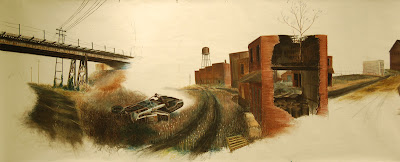.jpg)
Railroads in the United States usually formed the basis for a town or city, or at least were present early on in their development. The enormous economic growth railroads were part of caused a parallel growth of urban areas. In most cases, this growth encased the railroads as it was intricately tied to them as the major source of transportation. These original alignments - steep, curvy, and convoluted - were designed when freight trains were carrying several hundred of tons and might be a thousand feet long. At this point, freight trains are carrying from 5,000 to 20,000 tons, stretch between a mile and two in length, and use these routes in far greater numbers. On Amtrak's busiest route, the Northeast Corridor, passenger trains capable of 150 mph are rendered impotent at Baltimore, Wilmington, Philadelphia and New York, where the ancient infrastructure forces them to crawl at 30 mph.
That alone is an indictment of the present state of affairs in America, where no public effort or organization is possible to improve the efficiency of this major transportation corridor. Worse still are the social conditions of the area that it serves, the inner-city. Decades of industrial collapse and rising inequality have resulted in horrifying conditions of life for millions of people in these areas. Everyday, hundreds of thousands pass right through the thick of it on the train, some on the Acela Express. It's high-pricing and amenities - $199 to go from Washington to New York, a three hour trip - are meant to cultivate an elite market. The only way someone from the areas depicted could ride such an enormously expensive train is to work for Amtrak itself. Ironically, the decayed infrastructure of Amtrak prevents this elite express from ever going signifigantly faster than any other trains; it's 150 mph speed is possible in only a few areas between Washington and Boston.
All these pictures were taken as I rode on one of these segments, through Baltimore, Maryland. The view from the train shows an astonishing level of decay and misery in the city - hundreds upon hundreds of abandoned, trashed, and ruined houses and buildings crowd the landscape. In the midst of taking the pictures of the housing, I was told that it is illegal to take pictures from a train and that I needed to stop immediately. The conductor saying this was sympathetic, but forced to do so as an employee. Ultimately, the immense social inequality in the United States, as shown in these photos, is what provokes the ruling class to attack and abolish the most basic democratic and artistic freedoms. Every "suspicious" photo you see is here 100% illegal.
Recent comments have noted that the conductor was incorrect in stating this. This seems true, but it is what I encountered. Whatever the actual status of photography on or of trains, it should not be kept apart from the general roll-back of democratic rights, both in the United States and internationally (draconian anti-terror legislation has been legislation in Britain, Germany, Australia, Spain, Canada, Sri Lanka, France and elsewhere.)

.jpg)
.jpg)
.jpg)











.jpg)

.jpg)
.jpg)
.jpg)
.jpg)
.jpg)
.jpg)
.jpg)
.jpg)
.jpg)
.jpg)
.jpg)
.jpg)
.jpg)
.jpg)
.jpg)
.jpg)
.jpg)
.jpg)
.jpg)

